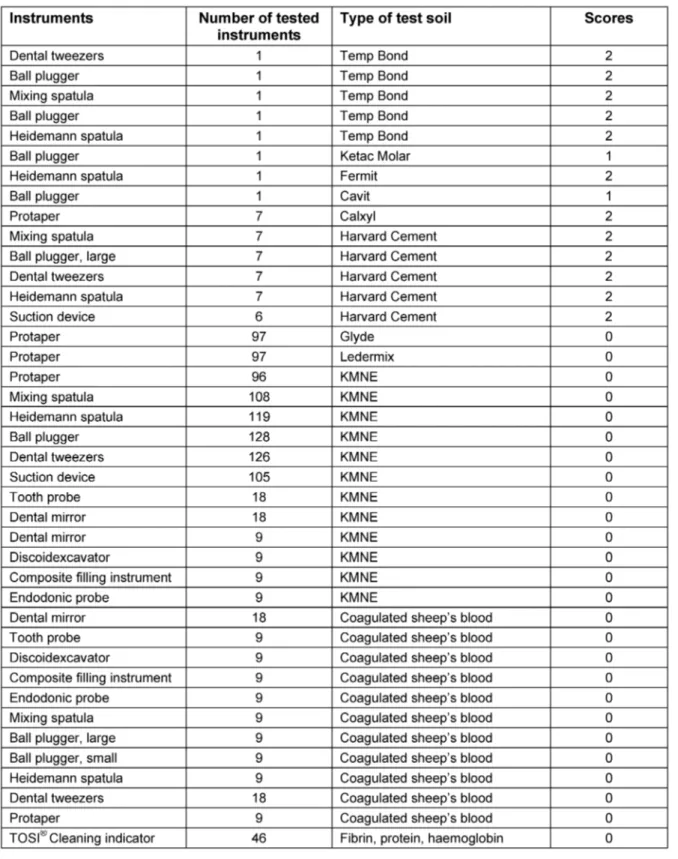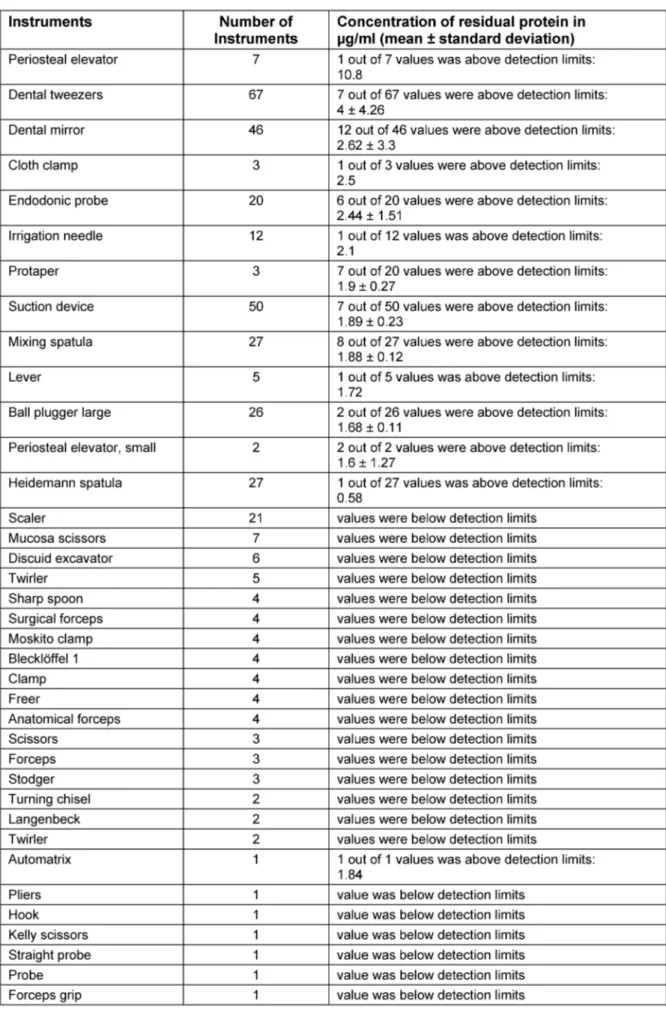Reprocessing of dental instruments in washer-disinfectors:
does a representative test soil exist in dentistry?
Aufbereitung des zahnärztlichen Instrumentariums im
Reinigungs-Desinfektions-Gerät: Gibt es eine repräsentative Probeanschmutzung?
Abstract
Background:Reprocessing of medical devices, being classified as semi- critical B is recommended to be performed in a washer-disinfector. In
Alexander Franz
1Margit Bristela
2order to estimate, whether the expected contaminants of the various
Fritz Stauffer
3medical disciplines can be effectively removed by this washer-disinfector, different so called “test soils” have been proposed to be tested as a
marker of cleaning efficacy of the disinfector. Todays described test 1 Bernhard Gottlieb University Clinic of Dentistry, Central soils are optimised for the testing of contaminations occurring in surgical
procedures, but not for dental procedures. Research Unit, Medical
Methods:In this study the test soils being proposed in the EN 15883- 5 (e.g. KMNE soil, recipe by Koller and coagulated sheep’s blood) were
University of Vienna, Vienna, Austria
compared with 8 reference substances used in the conservative-pros- 2 Bernhard Gottlieb University Clinic of Dentistry,
thetic dental practice. The success of the cleaning efficacy in the
washer-disinfector was checked visually and by determining the residual Department of Fixed and protein concentration on the contaminated instruments after the
cleaning procedure.
Removable Prosthodontics, Medical University of Vienna, Vienna, Austria
Results:It could be shown that in contrast to the proposed test soils of
the EN 15883-5, the used reference substances of the dental practice 3 Bernhard Gottlieb University Clinic of Dentistry, Hospital could not be removed by the washer-disinfector. Removal of these ref-
erence substances was only possible after manual or ultrasonic cleaning. Hygiene, Medical University of Vienna, Vienna, Austria Conclusions:Since blood plays a subordinate role as a contaminant of
instruments during conservative-prosthetic dental treatments, testing of the cleaning efficacy of the washer-disinfector with test soils according to the proposals of the EN 15883-5 is not representative in this discip- line of dentistry. Most of the materials used in dental practice can only be removed manually or with the help of the ultrasound bath.
Keywords:reprocessing, cleaning, disinfection, washer-disinfector, dentistry, test soil, protein assay, dental materials
Zusammenfassung
Hintergrund:Heute gilt für wieder verwendbares medizinisch genutztes Instrumentarium ab Klassifikation semikritisch B die Aufbereitung in einem Reinigungs-Desinfektions-Gerät (RDG) als Standard. Um erkennen zu können, ob die verwendeten Hilfsmittel bzw. vorkommenden Verun- reinigung der unterschiedlichen medizinischen Disziplinen maschinell effektiv entfernt werden können, wurden so genannte Probeanschmut- zungen vorgeschlagen. Die heute in Verwendung stehenden Probean- schmutzungen sind für chirurgische Instrumente, nicht jedoch für den zahnmedizinischen Einsatz optimiert.
Ergebnisse:Es zeigte sich, dass die verwendeten Referenzsubstanzen im Gegensatz zu den vorgeschlagenen Anschmutzungen im RDG nicht entfernt werden konnten. Eine Entfernung der Referenzsubstanzen war nur durch manuelle Vorreinigung oder Ultraschallbad möglich.
Schlussfolgerung:Da im konservierend-prothetischen Bereich nur ein geringer Anteil der Behandlungen mit Blutkontakt abläuft, die meisten zahnärztlichen Materialien aus diesem Bereich ohne manuelle Vorrei- nigung oder Ultraschallbad auch nicht ansatzweise durch RDGs entfernt werden können und der Kontaminationsgrad nicht repräsentativ für Verunreinigungen in diesem Fachbereich der Zahnheilkunde ist, kann die Reinigungsleistung gem. EN 15883 als Indikator für die Entfernung von verwendeten zahnärztlichen Materialien nicht getestet werden.
Dies stellt aber die generelle Aufbereitung des zahnärztlichen Instru- mentariums im RDG in Frage.
Schlüsselwörter:Aufbereitung, Reinigung, RDG, Zahnheilkunde, Testanschmutzung, Protein-Assay, zahnärztliche Hilfsmittel
Introduction
Today cleaning of reusable medical instruments in a dis- infector is the standard for surgical equipment. Repro- cessing of medical devices, being classified as semi-crit- ical B is recommended to be performed in a disinfector.
Therefore also in the dental practice the disinfector is more widely used.
In order to detect in advance, whether the expected contaminants of the equipment used during a surgical or medical invasive procedure are removed by the disin- fector, test soils were implemented.
According to the EN 15 883-5 standard [1], the cleaning efficacy of the disinfector as a part of the reprocessing cycle has to be tested with test soils on instruments, which resemble the expected contamination like for ex- ample blood contamination during the surgical procedure.
In the relevant standard, different test soils for different equipment are recommended. No test soil is listed resem- bling a contamination of typical instruments after dental procedures.
Oral instruments used in oral surgery or parodontology may have increased blood contact, but this is not the case in the field of conservative-prosthetic dentistry. This type of dental treatment dominates the treatment in a general dentistry practice. Only about 5% of these treat- ments are bloody. On the other hand materials like ce- ment play a big role and leads to contamination of the instruments.
The aim of this study was to compare the cleaning efficacy of disinfectors using dental instruments being spotted with test soils described in the EN 15 883-5 standard with reference substances, used in the daily work of conservative-prosthetic dentistry.
In preparation to this test series, the measurement results of residual protein on dental instruments, which were carried out in the past were analysed. The measurement of residual protein was performed routinely, to estimate high residual proteins on instruments, which could pose a problem in the cleaning efficacy of the disinfector.
Materials and methods
Test soils
As test soiling we used KMNE-soil, recipe by Koller [2], [3], coagulated sheep’s blood and 8 reference substances used in conservative-prosthetic dental practice (Table 1).
Instruments used in conservative-prosthetic dentistry and parodontology were soiled with KMNE-soil, reference substances and coagulated sheep’s blood. Exposure time of all test soils before reprocessing in a washer-disinfector (Miele G 7881) was one hour. Additionally, test bodies (TOSI®) were used for the monitoring of the cleaning per- formance of the automated washer-disinfector.
Quantitative protein evaluation
After reprocessing in a washer-disinfector each instrument was put in a separate sterile plastic container. 10 ml of sterile distilled water were added and plastic containers were put on a shaker for one hour. After one hour instru- ments were removed and remaining distilled water was transferred into a sterile test tube. Fluid samples were analyzed with a Micro BCATM Protein Assay Kit for the colorimetric detection and quantitation of total protein [4], [5].
Table1: Materials used in this study
Results
The majority of reference substances from the conserva- tive-prosthetic dental practice as cement and cement like material could not be removed from the dental instru- ments after reprocessing them in the washer-disinfector (Table 2).
The proposed test soils described in the 15 883-5 standard for instruments used in surgery, like coagulated sheep’s blood and also KMNE soil according to the recipe of Koller, were removed from all dental instruments after reprocessing in the disinfector (Table 2).
In daily practice even small remnants of these materials on dental instruments have to be removed manually prior
In the period 2007–2011 residual protein was measured out of a total of 384 instruments.
This was also applied to instruments from the area of oral surgery and parodontology. Increased residual protein could be detected in 57 samples (Table 3). The deter- mined protein levels were extremely low in almost all cases, and were only relatively slightly above the detection limit of the protein assay kit. Only one elevator showed a significantly elevated level of 10.8 microgram/ml of residual protein. It is noticeable that even for instruments, such as mixing spatula, which have no contact with mu- cous membrane slightly increased protein levels could be detected.
Table 2: Results for the test soiling with reference substances used in the conservative-prosthetic dental practice, KMNE-soil, coagulated sheep’s blood and TOSI®cleaning indicator. The evaluation of the samples was carried out using the following
scores: 0 = Test soil completely removed; 1 = Test soil not entirely removed; 2 = Test soil not removed
Table 3: Results for the determination of the residual protein concentration of instruments used in conservative-prosthetic, parodontological and surgical dentistry after reprocessing in a washer-disinfector
Discussion
Only few medical treatments in conservative-prosthetic dental practice result in a contact to blood. Furthermore most of the dental materials used in dentistry can not be removed without manual precleaning or the use of an ultrasound bath. The degree of contamination indicated by the use of KMNE-soil or coagulated sheep’s blood is not representative for soiling in this discipline of dentistry.
Therefore the assessment of cleaning performance used as an indicator for the elimination of adherent dental materials can not be tested.
This raises the question if after manual pre-cleaning or the use of an ultrasound bath the processing of dental instruments in a washer-disinfector is required. Further studies are necessary to clarify this problem.
Notes
Competing interests
The authors declare that they have no competing in- terests.
References
1. ISO/TS 15883-5. Reinigungs-Desinfektionsgeräte – Teil 5:
Prüfanschmutzungen und -verfahren zum Nachweis der Reinigungswirkung von Reinigungs-Desinfektionsgeräten. ÖNORM CEN ISO/TS 15883-5. 2006 02 01.
2. Koller W. Vergleich verschiedener Reinigungs- und
Desinfektionsverfahren an automatischen Steckbeckenreinigern.
Hyg Med. 1979;4:128-31.
3. Koller W. Reinigung und Desinfektion von Eßgeschirr, Instrumenten und Ausscheidungsbehältern im Krankenhaus – Grundlagen, Verfahren, Prüfung. Wien: Verlag Dieter Göschl;
1981.
4. Valdec D. Evaluation verschiedener Reinigungsverfahren von Winkelstücken im klinischen Betrieb der BGZMK [Diplomarbeit].
Wien: Bernhard Gottlieb Universitätszahnklinik, Medizinische Universität; 2011.
5. Schmid-Schwap M, Bristela M, Franz A, Kundi M, Piehslinger E, Stauffer F. Evaluierung der Reinigungsleistung von Geräten zur Winkelstückaufbereitung. Hyg Med. 2008;33(12): 518-21.
Corresponding author:
Alexander Franz, PhD
Bernhard Gottlieb University Clinic of Dentistry, Medical University Vienna, Sensengasse 2a, 1090 Vienna, Austria, Phone: ++ 43 (0) 1 40070/2622, Fax: ++ 43 (0) 1 40070/2609
alexander.franz@meduniwien.ac.at
Please cite as
Franz A, Bristela M, Stauffer F. Reprocessing of dental instruments in washer-disinfectors: does a representative test soil exist in
dentistry? GMS Krankenhaushyg Interdiszip. 2012;7(1):Doc13.
DOI: 10.3205/dgkh000197, URN: urn:nbn:de:0183-dgkh0001970
This article is freely available from
http://www.egms.de/en/journals/dgkh/2012-7/dgkh000197.shtml Published:2012-04-04
Copyright
©2012 Franz et al. This is an Open Access article distributed under the terms of the Creative Commons Attribution License
(http://creativecommons.org/licenses/by-nc-nd/3.0/deed.en). You are free: to Share — to copy, distribute and transmit the work, provided the original author and source are credited.

